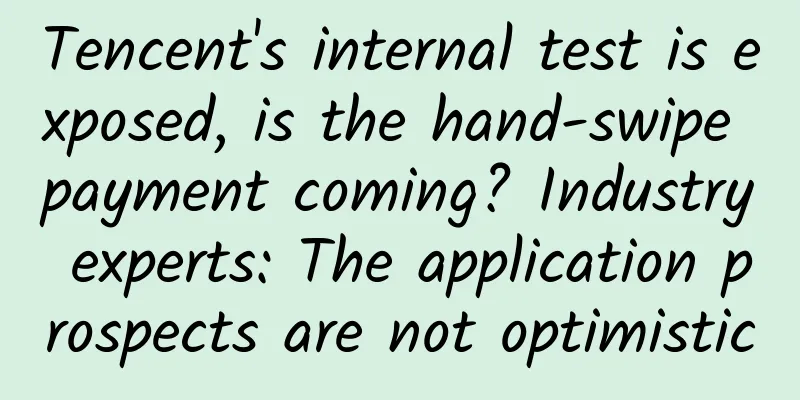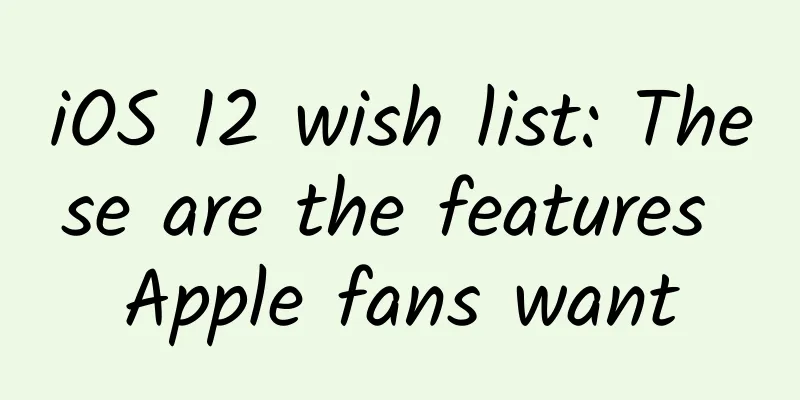Tencent's internal test is exposed, is the hand-swipe payment coming? Industry experts: The application prospects are not optimistic

|
"If you can pay by swiping your palm, you will really have to spend a lot of money in the future," said a netizen. Yesterday, the news that Tencent was testing the palm-swipe payment system spread like wildfire and quickly became the focus of netizens' attention. Many people expressed their opinions on the palm-swipe payment system, with some praising and some criticizing it. In response, Tencent said, "Payment by Palm is only a preliminary technical research for WeChat internally, and has not been tested yet, and there is no plan for its application at present." This obviously cannot stop the enthusiasm of netizens: What is palm payment? What is the difference between it and face payment? How is the security? How to solve the privacy problem?...... In this regard, AI Gold Rush interviewed industry experts and obtained several "secrets" about palm payment from them.
Face or palm? That is the question."The logic behind palm scanning and face scanning is actually the same. Both are a means of using biometric recognition technology to achieve contactless payment." A person working in the biometrics industry told AI Gold Rush. The so-called palm payment mainly uses "palmprint recognition technology", and its technical principle is roughly as follows: The palm print samples are collected for feature extraction, and then the extracted palm print features are stored in the database for matching with the classified samples. After the front-end device extracts the palm print features, the system matches them with the data in the database, and the payment is completed when the matching is successful. Establishing a database mainly consists of three steps, namely palmprint image acquisition, preprocessing and feature extraction.
Although it seems complicated, the industry insider said that if there is enough data, it is not difficult to realize "palm-swipe payment" technically. "Just like face-scanning payment, palm-scanning payment uses palm print features as the basis for judgment, but information such as geographic location, mobile phone number and personal account number can narrow the scope of data screened by the system and improve matching efficiency." Compared with face-scanning payment, palm-scanning payment is more reliable and secure. AI Gold Rush learned that there are two main types of information for palm print recognition: one is the palm print, that is, the lines on the palm; the other is the palm vein.
"It is more difficult to identify people through palm prints than through facial features, but it is safer. The promotion of face-scanning payment is not smooth because people attach great importance to privacy. Relatively speaking, palm-scanning payment may be an alternative option." Palm payment is not newAs early as 2014, Alipay demonstrated relevant payment technologies based on biometric recognition, including face, voiceprint, palmprint, etc., and launched "KungFu". Later, "face recognition" broke the circle and "face payment" became a new payment method. In 2015, the former Sichuan Panzhihua City Commercial Bank launched the country's first palm vein recognition bank self-service machine. Users can select the "palm vein" recognition mode, enter their mobile phone number, scan the palm vein through infrared, and enter the password to handle deposit and withdrawal transactions. In 2019, LG launched a palm-print unlocking mobile phone model G8S ThinQ, which allows users to unlock the phone by the shape, thickness and other features of the veins in the palm of their hand. Foreign e-commerce giant Amazon began relevant research in 2016 and released the palm print recognition technology Amazon One in September last year. The technology was initially used in the payment process of physical retail stores. Earlier this year, Amazon piloted a new palm recognition payment technology called "Amazon One" in three cashless Amazon Go stores in Seattle, USA. Consumers can pay by scanning their palms after binding their palm prints with payment cards or Amazon accounts. In the past month, Amazon has begun trying to promote its palm print payment. If users register their palm prints in Amazon's unmanned stores and link them to their Amazon accounts, they can get a coupon of about $10. Dilip Kumar, vice president of Amazon's physical retail business, said that palm print recognition was chosen instead of facial recognition and other solutions because it has more significant privacy advantages, because it is difficult to determine a person's identity through palm prints, and users must be close to the device and make meaningful gestures to enable it. In fact, whether it is Amazon or Tencent, as payment giants, their emphasis on palm payment is fundamentally based on the early layout of changes in payment methods. Biometric identification is becoming increasingly important for payment security, and it is a huge traffic entry point for Internet companies. For example, they can cover more sellers through payment devices, collect more user information, and use big data to develop other businesses. However, even though "Palm Swipe Payment" has advantages in security, it is still difficult to implement and even promote it on a large scale. The "three mountains" weighing on palm payment"This technology currently has no value in large-scale applications." The industry insider said that the reasons are mainly reflected in the following three aspects: The first is the issue of data.Palmprint recognition requires the collection of a person's biometric information, which is not easy to obtain. Firstly, people's awareness of protecting privacy is increasing, and secondly, the national policy on corporate collection of personal information is tightening. In December 2020, Tianjin issued the "Tianjin Social Credit Regulations", prohibiting market credit information providers from collecting a natural person's beliefs, blood type, diseases and medical history, biometric information, and other personal information prohibited from collection by laws and administrative regulations. "In relevant laws, only fingerprints are recognized, and the central bank allows facial recognition for payment, which is based on the fact that the country already has a fingerprint database based on ID cards and ID card photos for real identity verification." Therefore, if it is not possible to collect data samples on a large scale, there will be problems with the large-scale verification of palmprint recognition technology, and it will be difficult to establish a database, making it difficult to promote it on a large scale. The second is the issue of security.Although "palm payment" is safer and more reliable than face payment, there are even safer and more reliable fingerprint, finger vein and iris technologies. These two technologies are compliant at the legal level, and it is relatively easy to collect data. They have been applied in multiple scenarios, such as mobile phone unlocking and access control, and have better development prospects. Finally, there is the issue of practical application."The popularity of Touch ID and Face ID on mobile phones has made it easier for companies to collect information and build fingerprint and face databases, but there are no corresponding products that can collect palm print information." In other words, even if it is possible for companies to collect biometric information, it is very difficult to collect so much data. Because palm print collection requires "palm registration", there are currently no phenomenal products and applications to attract people to register, and the promotion cost is very high. “Even if a palm print database is established, ‘palm scan payment’ can only be a non-mandatory convenient service,” said the industry insider. Now that faces and fingerprints represent real personal identities, consumers are very wary of the security of their personal financial accounts and it is difficult for them to choose "palm payment" as their main payment method. Therefore, from the perspectives of technology, security, legislative compliance, and specific application promotion, "payment by swiping your palm" has many difficulties and problems. Although it is a technological innovation, its actual application prospects are not optimistic. "This should be a technical reserve made by large companies rather than a strategic deployment," the industry insider believes. This article is reproduced from Leiphone.com. If you need to reprint it, please go to Leiphone.com official website to apply for authorization. |
>>: I never use 5G, but why don’t I buy a non-5G phone?
Recommend
Did the solar system originate from a "floating cloud"? The scientific truth about the birth and evolution of the universe
Mainstream astronomers and astrophysicists agree ...
4 reasons why Microsoft Surface is doomed
The technology website Computerworld recently rep...
How to write good mobile product copy? Here is a very detailed specification guide
When we mention "design specifications"...
Luzhou Mini Program Franchise Company, how much does it cost to join a learning mini program?
What is the price to join the Luzhou Learning Min...
APP promotion strategy and operation ideas behind millions of users
Even good wine needs no bush. "Woniu Decorat...
A "mouth cannon" about architecture
Author: Duan Hechen The title of the article is v...
Analysis and solutions for common rejection reasons of financial apps
The APP review here refers to the AppStore review...
The third batch of astronauts will enter the Tiangong Space Station. How are Chinese astronauts selected?
On May 30, 2023, the successful launch of the She...
When a doctor writes an order for an IV, is he doing it for your own good or to cheat you out of your money?
Your child has a high fever. Give him an IV so he...
Yang Honghai interrupted the dispute between Yu Chengdong and He Xiaopeng over AEB: Kia cars all have it, what's new?
AEB (automatic emergency braking system) technolo...
How do funhouse mirrors deform people? How does bulletproof glass resist bullets? The secrets of glass in our daily lives!
Glass is very common in our lives. Whether it is ...
There are many types of disinfectants. Have you chosen the right one?
With the progress of science and technology, huma...
Why are 5G phones not selling as well as 2G phones in China?
Recently, the China Academy of Information and Co...
How to increase the APP review pass rate by 90%!
When you have read a large number of official ema...
Guangdiantong advertising introduction, Guangdiantong advertising placement
Guangdiantong is an advertising platform based on...






![Operation system [Introduction]: How to do promotion and marketing?](/upload/images/67cc34a76bdbf.webp)


